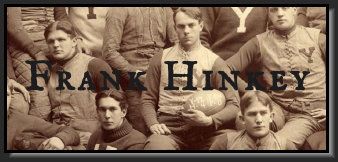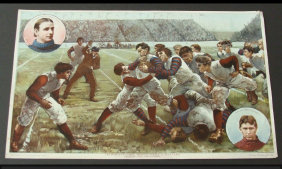





From the mid-1870's until the early 1890's the most prevalent form of headgear worn by American football players were knit stocking and skull caps. These lightweight wool and/or silk caps served several purposes: team identification, protection, and warmth. In an era when players on both teams wore identical canvas or moleskin jackets and pants, a cap's color and pattern enabled players to distinguish between friend and foe. A cap also cushioned blows to the ears, prevented hair pulling, and helped players retain warmth during cold New England fall and winter afternoons. The use of caps waned by the early 1890's as striped and colored jerseys worn beneath smock vests replaced the player identification function of the skull cap and the increased violence of the game rendered the minimal protection it afforded obsolete.

February 2020
c. 1891 University of Pennsylvania Football Skull Cap & Stockings

Only a handful of verified football caps survive today for a variety of reasons. First, not many were produced to start with. During their period of use (1875-1895), relatively few colleges and young men played football, particularly at the level where uniforms were issued to players. Second, a surviving football cap would today be over 130 years old, more than sufficient time for multiple generations of possessions to be discarded, destroyed, or moth-eaten and for all provenance to be lost. Third, skull and stocking caps weren't exclusive worn by football players. Similar caps were sold and used for other athletic endeavors, including hockey, polo, lacrosse, crew, bicycling, and skiing. Finally, the form and manufacturing techniques of the football skull and stocking cap continue to be used today, making dating vintage knitted items nearly impossible.
Our February 2020 Artifact of the Month is a remarkable surviving example with provenance, a circa 1891 football skull cap acquired from the descendants of Richard "Dick or Chrysanthemum" Simmons, the University of Pennsylvania's "end rush" between 1891 and 1893.
Our February 2020 Artifact of the Month is a remarkable surviving example with provenance, a circa 1891 football skull cap acquired from the descendants of Richard "Dick or Chrysanthemum" Simmons, the University of Pennsylvania's "end rush" between 1891 and 1893.
The cap, which has been woven in U of P's distinctive red and blue colors, exhibits minor fading and grass stains but otherwise remains in like-new condition. In addition to the cap, Simmons' descendants also saved his wool football stockings, that were unfortunately washed in 1969, leading to significant shrinkage and color bleeding. Regardless, the cap and stockings remain remarkably rare relics of nineteenth century American intercollegiate football.
Despite the unimpeachable family provenance, the cap's form did raise some questions. It doesn't possess the iconic skull cap pom-pom ball typical on nineteenth century skull caps and there are no photographs of U of P football players wearing this style cap, or any skull cap for that matter, during Simmons tenure with the team (1891-1893). In fact, by 1891 many collegiate football teams, U of P included, had stopped wearing caps altogether. However, the 1892 Spalding Intercollegiate Foot Ball Guide may offer a possible explanation. The guide includes an advertisement for the Spalding's new Elastic Foot Ball Cap, a tight-fitting, pom-pomless, woven silk skull cap matching the Simmons example that was "used for the first time last year by leading foot ball players." Given the near mint condition of the cap, we believe Simmons acquired Spalding's new innovation in anticipation of the upcoming 1891 or 1892 season, but along with his teammates, elected not to wear it. According to Simmons decendants and U of P records, Simmons didn't participate in any other sports during college.
Despite the unimpeachable family provenance, the cap's form did raise some questions. It doesn't possess the iconic skull cap pom-pom ball typical on nineteenth century skull caps and there are no photographs of U of P football players wearing this style cap, or any skull cap for that matter, during Simmons tenure with the team (1891-1893). In fact, by 1891 many collegiate football teams, U of P included, had stopped wearing caps altogether. However, the 1892 Spalding Intercollegiate Foot Ball Guide may offer a possible explanation. The guide includes an advertisement for the Spalding's new Elastic Foot Ball Cap, a tight-fitting, pom-pomless, woven silk skull cap matching the Simmons example that was "used for the first time last year by leading foot ball players." Given the near mint condition of the cap, we believe Simmons acquired Spalding's new innovation in anticipation of the upcoming 1891 or 1892 season, but along with his teammates, elected not to wear it. According to Simmons decendants and U of P records, Simmons didn't participate in any other sports during college.
Richard Henry Simmons
George Taylor Simmons (Simmonds) and Ann Emma Hocking were married in Penzance, England in January 1869. Ann gave birth to Richard Henry on July 5, 1869. George emigrated to the United States in 1869 and joined family members working in the coal mines near Shamokin, Pennsylvania. Ann and Richard followed George to the U.S. in 1871. By the mid-1880's George was listed as a grocer and dry goods merchant in Shamokin. Richard enrolled in the University of Pennsylvania Medical College in 1890. Known as "Dick" or "Chyrsanthemum" on the UP football field, the 5'-9" 167 pound Simmons played "end rush" during the 1892 and 1893 seasons. He graduated in 1893, opened a medical practice in Shamokin, and served as the Northumberland County medical inspector. Dick married Cora Bower Seiler in 1895 and the couple had one child that survived infancy, a daughter, Vera. Richard died on August 4, 1948 at the age of 79.
1892 University of Pennsylvania Football Team
Dick Simmons, 1892
University of Pennsylvania Football Game Photo, 1892
University of Pennsylvania Football Team, 1893
Richard Simmons
Dick Simmons, 1891
Football Cap Advertisement, Spalding Official Football Guide, 1892
Football Caps, Daniell & Sons, c. 1890


FrankHinkey.com
VintagePenna.com

Helmet Grading Code of Ethics
Vintage Helmet Grading Protocol
